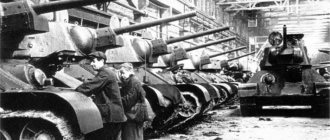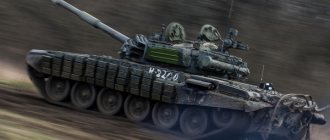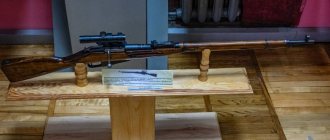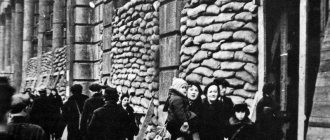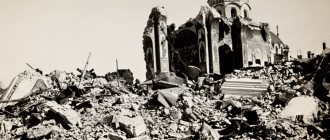Trophy teams during the Great Patriotic War
80 years separate us from the beginning of the Great Patriotic War. There is not a single family in our country that has not been affected by the war. We all carefully preserve the memory of the heroes who fought at the front and forged Victory in the rear. Today we will talk about a topic that has always remained behind the scenes of these great events.
Trophy teams.
Almost all wars pursue aggressive goals and it doesn’t matter what it is, a raid for live goods or “hiking for zipuns.” The emergence of huge armies and the scale of warfare led to an increase in the number of trophies. Moreover, captured equipment and equipment were re-equipped and used by the warring parties. In World War II, the Germans were ahead of the rest in this regard. Its armies included military equipment captured in France and the Czech Republic, and after June 22, 1941, Soviet equipment. The Germans prepared for the robbery in advance, having previously created units that would economically use everything they could capture. They even began their attack on the USSR in June, so that our collective farmers had time to sow agricultural products, and they could harvest the harvest. It’s strange, but the leadership of the Red Army, based on an offensive doctrine and who were going to fight only on foreign territory, did not at all provide for the seizure of trophies and the forms of their use.
At the beginning of the war, there was no captured service as such in the Red Army, and only in August 1941 did it become independent. In the Center, the evacuation department of the Red Army Logistics Headquarters took over the organization of trophy affairs, and evacuation departments at the fronts. Special commissioners dealt with captured and unusable property, and warehouses were created to store them. Similar services appeared in armies, divisions and even regiments.
After the defeat of the German group near Moscow, hundreds of combat vehicles and self-propelled guns, thousands of tons of military equipment were captured. Such a mass of captured weapons required the State Defense Committee to take appropriate measures. In just six months of 1942, 15 relevant orders were issued, and a plan for the delivery of scrap and non-ferrous metal waste was approved. The units created for this purpose could not cope with the increased tasks, and in January 1943, Stalin signed the GKO Decree “On the collection and removal of captured property...”. The Central Commission was headed by Marshal Budyonny.
Changes were made to the management of trophy services. Army trophy battalions and special dismantling platoons at army warehouses began to deal with trophies. Railway evacuation trains became an innovation. Each such train had a crew of 200 people and up to 20 powerful tractor-tractors. Means have appeared for lifting sunken heavy equipment. At the end of 1943 and the beginning of 1944, the captured teams began to lag behind the advancing Soviet troops. Measures have been taken to enhance the mobility and efficiency of these services. Now, captured companies, dismantling platoons and captured warehouses were added to the mobile units that were the first to enter enemy lines. At this time, the Regulations on Trophy Bodies were adopted, which clearly formulated the tasks of trophy owners. The Regulations indicated the need to involve local residents in the collection of captured and domestic weapons and property. This work was coordinated by Village Councils and District Executive Committees. Participants in the gathering received monetary rewards. For example, 3 rubles were paid for one serviceable helmet; for 10 serviceable helmets you could get 490 rubles. Local residents were also recruited to guard the collected captured weapons.
Forward to the West...
With the crossing of the Soviet border and the transfer of hostilities further to the West, the volume of work for captured units also increased significantly. Along with battle trophies, our troops began to return economic property and cultural property looted by the enemy. In the Odessa region, 1,900 wagons were discovered with property looted by the Nazis in Ukraine and not having time to remove it. On the Danube, in the ports of Bulgaria and Romania, 109 barges with looted goods were detained. Factories and warehouses were not difficult to account for and protect, but stolen property required establishing its ownership and sending it to its destination.
Trophy teams did not stop only at recording and preserving property, they provided assistance to the population in the liberated areas. Helped partisan detachments and allied formations. At the end of the war, the workload of captured organs increased significantly. In June 1944, they were given the task of clearing all ports and railway stations located in the rear of Soviet troops from trophies and explosive objects. By the beginning of 1945, 3,574 stations and 12 ports had been cleared. The services also successfully handled the shipment of military equipment and scrap metal. In 1944, 130,344 wagons were shipped.
Epilogue.
Summing up, we can say with confidence that the captured services, starting almost from scratch, and having experienced certain difficulties, coped with the tasks. As a result of the work carried out, 24,615 tanks and self-propelled guns, 72,204 guns, and more than a hundred million artillery shells were assembled. All these weapons would be enough for another “victorious” war.
Some of the weapons were transferred to the partisans, some entered the national economies of Bulgaria, Yugoslavia, Hungary, and Czechoslovakia. The weapons captured from the Kwantung Army were transferred to the Chinese government. Machines and tractors were actively used to supply our troops.
In 1942, the Pravda newspaper wrote that the collection of scrap metal was a big state matter. So the lion's share of this scrap metal was provided by trophy teams. During the war years, captured teams sent 6,008,285 tons of scrap metal to the rear, including 165,605 tons of non-ferrous metal.
In our short story it is simply impossible to tell about everything that the captured service did. The main thing is that she did a great job of collecting, sorting, accounting and sending captured property to the rear, which in the end became a significant contribution to our common Victory.
Trophy takers. 1942
“I arrived in the glorious Russian city of Voronezh at the beginning of the 20th of September 1942 along with other marching soldiers and was enlisted in the 25th Tank Corps (40th Army). More precisely, together with three other comrades, he was assigned as the head of the ammunition supply of the 16th motorized rifle brigade to a group for collecting captured small arms. As they explained to us on the very first day, it was about obtaining weapons directly on the front line. The commander of the group of so-called “trophy men” was appointed a junior commander with the rank of foreman named Fadeev, who already had combat experience. The rest, including the author of the notes, are ordinary Red Army soldiers of various ages - from 18 to 38 years old, who have just experienced the hardships of war.
In the building of the Voronezh hydroelectric power station, located in the eastern suburb of Voronezh - Pridacha, on the left bank of the river, where the headquarters (or logistics service of the 16th MSB) was located, we, like other newly arrived soldiers, were introduced to the order of the People's Commissar of Defense No. 227, better known entitled "Not a Step Back". By the way, it mentioned the battles that unfolded from the Voronezh region on the Don to the North Caucasus, as well as the breakthrough of the invaders to Stalingrad. At the same time, our “chief boy,” as we called him among ourselves (which meant the chief of ammunition; unfortunately, I did not remember the name of our commander), announced that today we had to deliver several boxes of rifle cartridges to the front line, to the Chizhevsky bridgehead , in which the 2nd battalion (16 SMEs) is in great need. And at the same time, we will get the opportunity to familiarize ourselves with the advanced positions occupied by the brigade and begin our main work of obtaining weapons. He himself had apparently been there and knew the situation quite well. And it was captivating. True, he mentioned that as our working norm he considers the result - 4-5 rifles per night for each person, or a light machine gun equivalent to 3-5 rifles, which we must deliver to the power plant building in Pridacha by morning. +++++++++ After receiving the boxes of ammunition, which, by the way, were not only heavy, but also very inconvenient to transport, especially under fire, the commander took us to the bank of the Voronezh River to show us the path along which we should have made our way to destination. The initial section of the route, including the river crossing, was clearly visible in the bright sun. However, a stunning picture opened before us, even for us who had already seen the views. In the area of the crossing and beyond, at least half a dozen of our “thirty-fours”, shot down by the Germans, were visible. These were still unresolved traces of the recent heavy battles for the Chizhevsky bridgehead, in which tanks, as well as infantry, had to cross a fairly vast terrain open to the enemy on three sides, and they were literally exterminated with almost impunity. Telling us how to get safe and sound to the Chizhevsky bridgehead and deliver the cargo entrusted to us there, the head of the ammunition supply warned that the crossing and the surrounding area are bombed daily (and sometimes more than once a day) by enemy aircraft and advised that in the event of a raid, find shelter on one of branches of the river in order to cross to the right bank under cover of darkness. The first attempt to do this was unsuccessful. Before we had time to descend to the crossing, we came under a bomb attack from German planes, trying to find protection at an apparent shelter - the downed "thirty-fours" standing at the crossing. Waiting for the evening downstream of the river turned out to be not much safer. Until the end of the day, we came under enemy air raids twice and once under mortar fire. We managed to reach our destination only in the evening. ++++++++++ Our team completed the first task. And after a couple of days we got used to the real conditions of obtaining “captured” weapons, both ours and the German ones found on the front line. The distances between the positions occupied by our troops and the German ones in the city were small, and sometimes weapons were obtained dangerously close to the Germans. It was no less difficult to take him out of the battlefield, or rather, to crawl with him to his trench. Not every night we were able to meet the quota for obtaining weapons, which was mentioned above. Thank God, our chief boy understood well the conditions under which we mined it. Moreover, we tried to do as much as possible. Sometimes, when the catch was for some reason unsatisfactory, we remained on the front line until the next night to carry out reconnaissance, which was only possible in daylight. We worked in two pairs, because it was more productive and convenient in frontline conditions. But all four of us stayed together together. By morning, we brought everything we had mined to the power plant building, fed there, and then moved to no-man’s dugouts in the Pridachi area for the day’s “overnight,” and at dusk we set off again to the bridgehead with a call at Vogres. Repeatedly we received orders there to deliver weapons repaired in the rear to our troops. I remember that the most inconvenient thing was to carry even a Maxim heavy machine gun divided into two parts. ++++++++++ In general, during three weeks of fighting in Voronezh, we probably obtained at least two hundred small arms - domestic and German. These were: rifles, less often - machine guns, light machine guns, pistols. We ourselves never counted how many weapons we took from the battlefield. Perhaps, after the corps left for formation in the Khrenovoe district, where two of our team were involved in the work of cleaning captured weapons, we were able to make sure that there were a lot of them. And then they remembered the parting words of the commander: “Until you bring out enough weapons to arm a full brigade, they will not be recalled from the front line to the formation.” One day, with the help of comrades from our battalion, we managed to take away a 45-mm anti-tank gun that had once been abandoned from under the enemy’s nose. It turned out to be completely intact and became the property of the artillerymen there, on the bridgehead. I was awarded the rank of sergeant and, after a short training in an improvised “forest” school for junior commanders, I was appointed assistant platoon commander in the second rifle battalion of the 16th infantry infantry.” - from the memoirs of sergeant of the 16th MSB L. Miroshnikov.
The main question is how were captured small arms used in that Red Army? It’s one thing if you have a standard weapon (the same Mosin rifle) to have some kind of trophy like a German submachine gun, another thing is that it’s an officially issued weapon, which the command was also obliged to supply with ammunition. It’s clear with armored vehicles), destroyed tanks were centralized into one place and tank battalions and brigades were formed from them. But how was the accounting of small arms carried out? They were collected and registered as weapons, and then officially issued to employees of the Red Army. For example, a piece of a military book. The German rifle and its number are clearly stated there.
and here on our forum, we collect photos of trophy winners. If anyone has anything to add, we will be glad to help.
Thank you
- Comments (2)
Comments
kess 2014-04-08 10:39 The uniforms, it seems, were also issued from trophies.
+2 Griffe 2014-04-09 10:42 Interesting, didn’t know that. I believed that the trophy hunters collected weapons and ammunition in already controlled territories and from prisoners of war, and captured warehouses arrived. But it turns out that they collected them, almost in front of the enemy’s eyes, and immediately handed them over to units.
Update list of comments RSS feed of comments for this entry
Comments can be posted only by registered users.
JComments
“Trophy-takers” of the GRU: what Soviet special forces did in Vietnam
According to the data given in the book of the Vietnam War veteran, Nikolai Kolesnik, “The Vietnam War... How it Was (1965 - 1973)”, a group of specialists supervised by the Main Intelligence Directorate of the General Staff of the Armed Forces (GRU General Staff of the Armed Forces) of the USSR, whose task was to study American war trophies, worked in Vietnam since the fall of 1965 (according to other information, since May of the same year).
The results of the work of the “trophy hunters” were of great interest to the USSR Ministry of Defense and the Soviet defense industry.
Vietnamese comrades made it difficult
According to the memoirs of veteran diplomatic service Anatoly Zaitsev, published in Krasnaya Zvezda, Soviet diplomats nicknamed this special unit of several reserve officers led by a GRU officer “trophy hunters.” The tasks of the “trophy hunters,” in addition to studying and sending samples of American equipment and weapons to the Soviet Union, also included analyzing the conduct of American combat operations in Vietnam and advising the Vietnamese People’s Army on developing ways to counter enemy units.
Judging by a certificate from the USSR Embassy in the Democratic Republic of Vietnam, dated March 1967 and addressed to the top leadership of the Soviet Union, the normal work of the special group of “trophy hunters” was often impeded by the Vietnamese side. Diplomat Viktor Zvezdin wrote that at that time, Soviet specialists had been working in Vietnam for almost 2 years, since May 1965, and their activities were coordinated at the level of the Ministers of Defense of the USSR and the Democratic Republic of Vietnam. During this period, the “trophy hunters” selected and sent to the Soviet Union more than 700 samples of American military equipment and weapons - the GRU special forces examined downed US Army aircraft, missiles, electronic, photo-reconnaissance and other weapons. In addition, based on the results of this work, several dozen information and analytical reports were compiled, in which American technical documentation was also studied.
Most of the research was carried out at the crash sites of downed planes. Viktor Zvezdin wrote that the Vietnamese often hid these points from the Soviet special group or delayed sending vehicles with “trophies” to the object of study. In this regard, the “trophy hunters” had to track down the places where American planes fell. It happened that the Vietnamese simply did not allow Soviet specialists to examine samples of equipment and weapons, and delayed sending them to the USSR (it could take up to 3 months). Many cases were also due to the fact that before the American plane arrived at the crash site, its remains were already being sorted out by Chinese military experts.
According to Zvezdin, in January 1968, the Chinese were ahead of the Soviet special group by being the first to dismantle an enemy modernized reconnaissance aircraft - they removed everything valuable from it, and prepared the wreckage for an explosion. The Vietnamese, in order to somehow smooth out the unpleasant situation, handed over to the “trophies” an American Shrike missile (AGM-45 Shrike).
In general, diplomat Viktor Zvezdin in his memorandum expressed concern about the current situation with the study and sending of trophies to the USSR and proposed drawing up a special bilateral agreement that would improve cooperation between Vietnam and the Soviet Union in this area.
This certificate is referred to by the Kommersant-Vlast publication (where it was published); the fact that the Vietnamese military obstructed the work of Soviet special groups is confirmed by other sources. At the same time, the Kommersant journalist, having met with Viktor Zvezdin, notes that the former Soviet diplomat denies his authorship and the very existence of the above-mentioned memo.
What is Shrike?
According to Vestnik Air Defense, the decrease in the effectiveness of the anti-aircraft missile forces of the Vietnamese army was largely facilitated by fire strikes on the positions of the Soviet Dvina air defense systems with radio-homing bombs - the American AGM-45 Shrike.
A specialist from one of the special groups of “trophy hunters,” Alexander Anosov, wrote that the complex for tracking our air defense systems was handed over to the Americans by the Israelis, who, in turn, captured it from the Egyptians. The moment the Shrike was launched from the bomber, the locators of the Soviet anti-aircraft missile system recorded and immediately turned off the radio transmitter. The missile lost its target and the “blinded Shrike” often flew into residential areas of Hanoi.
Using information about the Shrike, the Soviet defense industry repeatedly modified the Dvina air defense system, including during the Vietnam War. The special group, which included senior lieutenant engineer Alexander Anosov, worked in Vietnam from May 1965 to December 1968, often under bombing, artillery shelling and in mined areas. As a result, during this time, Soviet specialists selected and sent to the USSR more than 800 samples of American equipment and weapons.
The number of special groups and the effectiveness of their work
According to the calculations of the Chairman of the Presidium of the Interregional Public Organization of Veterans of the Vietnam War, Nikolai Kolesnik, military scientific groups sent from the USSR to Vietnam through the GRU operated in the DRV until 1971 and were led during this time by seven career officers of the Main Intelligence Directorate (all colonels ). Kolesnik names the total number of “trophy men” (they were civilian defense specialists, mostly retired officers) for the entire time of the Vietnam campaign - up to 50 people (5 people in a group), less than a dozen are alive today. At one time they were not considered participants in the hostilities.
... Documented, convincing data on how trophies obtained by military-scientific special groups of the GRU during the Vietnam War and transported to the USSR influenced the modernization of equipment and weapons of the Armed Forces of the Soviet Union has not yet been made public. The Kommersant-Vlast publication, analyzing this topic, is inclined to conclude that the domestic military-industrial complex in the 60s and 70s, during the Vietnam campaign, became the owner of “almost all the new products of American technology” and subsequently began to reproduce them.
★ POPULAR PRODUCTS★
"Go"
Stalin's fight against the "trophy hunters"
As noted above, after the war in the Soviet Union the crime situation sharply worsened. This was due to several main factors: 1) vast territories were occupied during the war, the main Soviet institutions in them were liquidated, the Nazis consciously collaborated with local Nazi and collaborationist circles, and after the liberation of these areas it was necessary to restore order, de facto lead a new war against gangs, Nazis;
2) a significant part of the personnel of law enforcement and security agencies went to the front, many died, this weakened law enforcement forces;
3) criminals used the war and the weakening of law enforcement forces to strengthen their positions;
4) the war gave the bandits real military weapons. It was easy to obtain, the fields were strewn with weapons and ammunition;
5) during the war, the authorities, in order to somewhat alleviate the situation of the people, turned a blind eye to the development of the “gray market”; a “black market” also appeared, where in most cases, in addition to trophy trade and speculation in products, the gold and foreign exchange business flourished brightly.
For example, in May 1946, an operation was carried out by employees of the UMGB in the Moscow region to eliminate four groups of 12 people related to the purchase of gold and currency. During the search at the apartments of the arrested, the following items were seized: gold coins of royal minting worth 16,335 rubles, gold items with diamonds worth 74 thousand rubles. total weight 14.7 kg, 5022 dollars, 120 pounds sterling, 304 thousand rubles. cash, bearer savings books with deposits worth 105 thousand rubles, government bonds worth 294 thousand rubles. In June 1946, employees of the Ministry of State Security and the Ministry of Internal Affairs of Leningrad, during Operation Predators, caught red-handed the famous currency traders Miletin, Eidin and a secret group of gold currency traders headed by Chernigov and Rabinovich. The analysis carried out during the investigation showed that gold and currency were often purchased cheaply from the population, including from demobilized soldiers and officers of the Red Army.
Since the war, speculative businessmen have chosen state-owned collective farm trade. Having in hand documents (often forged) about contractual relations with collective farms, businessmen opened their own points in the markets, where they sold collective farm products at speculative prices. In addition to such “stationary workers,” there were various groups of so-called “purchasers” operating throughout the Union, who were directly involved in purchasing grain at state prices and then selling it in regional centers at higher prices. According to data from the Ministry of Internal Affairs and the Ministry of State Security, in the first quarter of 1947 alone, 17,784 people were brought to criminal responsibility for profiteering. At the same time, 2932 organized groups were identified, from which during the search the following was confiscated: 23,743 rubles. coins of royal minting, 4 kg of gold bullion, more than 19 million rubles. cash, manufactured goods worth more than 15 million rubles. and 325 tons of food products (from the book “Post-war Moscow. 1945-1947”);
5) the largest cities, like Minsk, Kyiv, Leningrad, Stalingrad, Sevastopol, Odessa, Novorossiysk, Voronezh, etc. were heavily destroyed. The total number of destroyed cities and large settlements was 1,700 and more than 70 thousand villages. 25 million people were left without a roof over their heads, which, in turn, led to overcrowding in the rear cities;
6) part of the industry was destroyed (32 thousand enterprises were destroyed), demobilization of the army began. Soldiers and officers returned home with trophies, however, despite the shortage of labor, it was not easy to find work in early 1946 in a number of areas;
7) in addition, starting in 1946, mass re-evacuation began in the country (more than 25 million people were evacuated to the east during the war). Thus, war, devastation, migration, reinforced by the processes of mass demobilization and repatriation, led to an increase in criminal and organized crime in the economic sphere.
All this led to the “materialization” of the Soviet Union and threatened the collapse of the Soviet project. "Getting money" became a characteristic feature of the post-war period. The growing demand for scarce goods led to the formation of “wealthy people” in Soviet society, engaged in personal enrichment. The number of “wealthy people” included representatives of the generals, Soviet and party bodies, who made a fortune through “righteous labor,” including during the distribution of “trophy property” received during reparations.
The problem was that in many regions of the USSR, in addition to the increase in criminal offenses, there was a tendency for business executives to become intertwined with crime. Criminal activity in the economic sphere increased sharply: illegal business activity intersected with theft of state and public property, various frauds, speculation in the trade and supply system. Organized criminal groups acted in close cooperation with individual managers and employees of trade and public catering enterprises. For example, only in the Ulyanovsk region. a criminal group headed by regional food industry leaders managed to steal food worth 2.7 million rubles.
It is clear that the Kremlin could not turn a blind eye to this situation, when the “filth” of materialism was corroding the elite of Soviet civilization - the senior command staff of the armed forces, employees of Soviet and party bodies (according to Stalin’s idea, they were supposed to become the “Order of the Sword Bearers”, which would be a model for all the people). Stalin himself set such an example, leaving nothing behind him except a superpower and the Soviet project, which gave a chance for a “bright future” not only to the peoples of Russian civilization, but to all of humanity. It was impossible to turn a blind eye to the decomposition of part of the Soviet elite, since the craving for the “golden calf” undermined all the foundations of Soviet civilization, the essence of which was social justice, the rejection of the parasitism of a small social group over the entire people. Hence the “trophy case”, the “small purge” of the party elite, the fight against “cosmopolitanism”, etc.
Thus, in July 1946, the Central Committee of the All-Union Communist Party of Bolsheviks considered several cases of secretaries of territorial regional committees, in particular, the Irkutsk and Sverdlovsk regions. The Irkutsk case began with a letter from the Commissioner of the CPC under the Central Committee of the All-Union Communist Party (Bolsheviks) for the Irkutsk region, Comrade. Frolov, sent on June 8, 1946 to the CPC in the name of Shkiryatov. The letter spoke about the abuse of management of the Irkutsk region. In particular, illegal expenditure of public funds was noted for holding parties and purchasing cars for personal use. “Some comrades, having bought cars at a low cost in the stock property department of the East Siberian Military District, resold them at higher prices. The head of the ORS of the Glavmuka trust, Comrade Ponomarev, bought 2 cars for 17 thousand rubles, he sold one of them to the head of the Angarsk Shipping Company, Comrade Karamzin, for 24 thousand rubles; deputy prev the regional executive committee, Comrade Kulikovsky, bought 2 cars, of which he resold one; the director of the power plant, Gurevich, resold his car, and other employees resold their cars. “On the instructions of the Secretary of the Irkutsk City Committee of the All-Union Communist Party of Bolsheviks, Comrade Kobelev, products supplied by the state for children’s institutions: butter, chocolate, sugar, cookies, etc. in the amount of 1,452 kg were distributed as gifts to the city’s leading employees.”
Thus, the leadership of that time demonstrated the “elitism” and corruption typical of all times. However, then they could be punished, and very severely. In modern times, similar crimes usually get off with reprimands.
It is worth noting that the tightening of penalties introduced by the Decrees of June 4, 1947, for economic crimes (speculation, fraud, currency transactions, major theft of state and cooperative property, mediation, giving and receiving bribes) influenced the decrease in the level of these crimes, which amounted to 49.2% of the total. The crime rate began to decline in mid-1948. The death penalty, even for major thefts, was used extremely rarely during this period.
As part of the general fight against abuses, some generals and officers also came under attack. On November 29, 1947, MGB Minister Abakumov sent Stalin a voluminous report, which reported on the negligent performance of duties and the use of official position for personal gain by a number of senior officials of the SVAG in the period 1945-1946. The materials testified to the malicious theft of trophies, various violations in “trophy matters” committed by both senior army officers and the command staff of the Ministry of Internal Affairs-MGB. It is worth noting that similar information was received by the Central Committee addressed to Stalin and, in addition to the Ministry of Internal Affairs-MGB, in letters from military personnel and ordinary Soviet citizens.
Here is a typical example. “...This is what his subordinate, junior lieutenant Maksimov, said in a letter to Stalin about the head of the district department of the MGB in Altmark, Major Tolstoy: “In May 1946, operational workers of the district department of the Altmark district discovered a warehouse with sugar of one retired military unit, which had left for an unknown reason warehouse with sugar amounting to 36 tons. This sugar, on the orders of Major Tolstoy, was transported at night from the Gentin region to the mountains. Stendhal. From that time on, Major Tolstoy began to dispose of this sugar as his personal property. Part of the sugar - three tons - was handed over to the authorities so that no complaints would arise. About ten tons were distributed to employees in exchange for silence. The rest of the sugar went to various deals with the Germans in favor of Major Tolstoy. He specifically sent the civilian repatriated Nadezhdin Nikolai 4 times throughout the occupation zone of Germany with the goal that Nadezhdin would exchange sugar and meat from the Germans for various rags for Major Tolstoy. Thus, also consuming state gasoline. Major Tolstoy sent all the things exchanged from the Germans for sugar and meat to the Soviet Union to his place of residence in the mountains. Kharkov with his orderly ml. serge. Mazharin, who serves him only for this purpose, does not work anywhere, and goes to the Soviet Union on vacation 3 times a year. Then, in 1946, Major Tolstoy hid from the state a subsidiary farm of 160 sheep, about 30 cows and 4 pigs and various poultry, the local commandant’s office knows about this fact. This subsidiary farm was almost destroyed, some of the livestock went to the common boiler, and most of it was converted into various sausages, canned food and sent to the Soviet Union in the mountains. Kharkov to his mother-in-law and for various geshefts in favor of Major Tolstoy, when in the canteen the operational staff sees almost no fat, since Major Tolstoy for 5 months tore off fat from the main ration of his employees, thereby accumulating 45 kilograms of butter, he also sent it to the mountains. Kharkov to his mother-in-law. This communist does not hesitate to go into the apartments of employees, not for the purpose of talking with their wives, but on the contrary, he goes to the apartments in order to take personal belongings from the employees for his own benefit and for the benefit of the newly arrived boss, Lieutenant Colonel Denisenko. Seeing such actions of their boss, some employees embarked on the same path...” (E. Zhirnov, “I get drunk and indulge in junk”, “Power”, No. 49 (703) dated December 11, 2006).
It must be said that all mid-level military personnel “caught red-handed” in trophy enrichment were minor figures. The military prosecutor's office looked at such cases with a blind eye, taking into account the past military merits of one or another caught "shopper." Therefore, many military men got off with simple fright. But Stalin perceived this issue somewhat differently. He looked wider. The point was not at all in the number of trophies, but in the fact that the enrichment (not always legal) of the generals through trophies, in fact, corrupted the army. And in conditions of a general increase in crime, the penetration of corruption into state and party structures, this threatened in the future a coup d'etat, which could destroy the entire Soviet project (as it eventually happened in 1991).
That's why some generals suffered, so that others would be discouraged. December 6, 1947 Chairman of the Council of Ministers of the USSR I.V. Stalin (having studied the material presented by Abakumov on November 29) gives instructions to arrest General G. A. Bezhanov. There was sufficient compromising material against him. Bezhanov was a businessman by training, then he joined the ranks of the spacecraft and advanced through state security. During the war he was involved in organizing evacuation and supplies. From 1943 he worked as head of the USSR NKGB Directorate for the Stavropol Territory, from October 1944 as People's Commissar, from March 1946 as Minister of State Security of the Kabardino-Balkarian Autonomous Soviet Socialist Republic, and from May 1945 as head of the NKVD operational sector in Thuringia. The Minister of State Security of the Kabardian Autonomous Soviet Socialist Republic, Major General Bezhanov, was arrested on December 10, 1947 in the trophy case and sentenced by the Military Collegium of the Supreme Court on October 17, 1951, according to the Decree of the Central Executive Committee of August 7, 1932 and Articles 193-17 a of the Criminal Code of the RSFSR to 10 years in prison.
This was followed by the arrest of the head of the operational sector of the federal state of Saxony, Major General S.A. Klepov on charges of abuse of power and abuse of official position, with subsequent delivery under escort to Moscow. Klepov also served in state security in railway transport. Since November 1946 - head of the Saxon operational sector of the Soviet military administration in Germany. Led the formation of a network of state security agencies in the occupied territory of Germany; enjoyed the patronage of the Deputy Commander-in-Chief for Civil Administration Affairs I.A. Serova. He was involved in large-scale thefts of trophy property. He was sentenced to 10 years in prison. Others followed. On January 31, 1948, the military counterintelligence agencies of the MGB arrested the former head of the Berlin operational sector, Major General A.M. Sidneva. In 1951, at a special meeting of the USSR Ministry of State Security, he was sentenced to compulsory treatment in a psychiatric hospital.
It is obvious that Zhukov also dabbled in trophies. But taking into account his military merits, he escaped with disgrace. As you know, one day, December 6, 1947. Military counterintelligence officers arrested General Bazhanov and Lieutenant Colonel A.S. Semochkin (adjutant of Zhukov). Both of them quite quickly and in detail presented to the MGB investigators various facts related to the activities of Zhukov as Commander-in-Chief of the SVAG and his inner circle. On January 5, 1948, Abakumov (in accordance with Stalin’s orders) ordered MGB officers to conduct a secret search in the Moscow apartment of Marshal Zhukov. A significant amount of valuables were found there.
Secretary of the Central Committee of the All-Union Communist Party of Bolsheviks A.A. Zhdanov gave instructions to double-check all the facts indicated by Zhukov. At the same time, an inspection team of the Ministry of Military Affairs was sent to the Odessa Military District, which identified a number of “oversights and gaps” on the part of the OdVO commander. On January 20, 1948, the Politburo of the Central Committee of the All-Union Communist Party of Bolsheviks issued a resolution “On Comrade G.K. Zhukov, Marshal of the Soviet Union.” The Central Committee, by its resolution, “... issued a final warning to Comrade Zhukov, giving him the last opportunity to correct himself and become an honest member of the party, worthy of the rank of commander.” At the same time, Zhukov was released from his post as commander of the Odessa Military District. Zhukov was appointed commander of the Ural Military District.
Thus, Stalin fought with high-ranking “trophy takers”, showing that he would not allow the army and the entire Soviet elite to disintegrate. It must be said that this is one of the main reasons for hatred of Stalin. He led the Red Empire into the future, “to the stars.” And the representatives of the “elite” with the psychology of the bourgeois and the bourgeoisie wanted to enrich themselves, because they found themselves on the “Olympus” and wanted to take advantage of their position.
Therefore, during Khrushchev’s “perestroika,” a myth was launched that Stalin wanted to “overthrow” Zhukov, and Abakumov, on his instructions, came up with the “trophy case.” This black myth is still popular today. Stalin, the bloody “tyrant,” is contrasted with the “brilliant commander,” “knight” Zhukov. As a result, Zhukov escaped with disgrace. And after Stalin was eliminated, he became Khrushchev’s instrument in the struggle for power.

